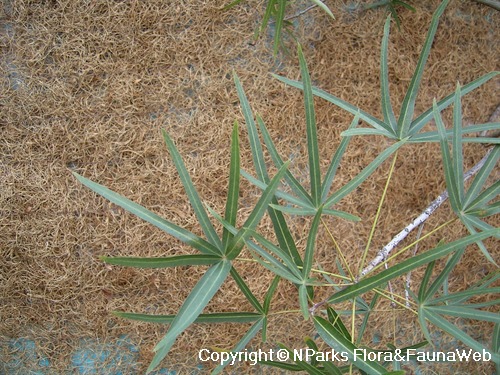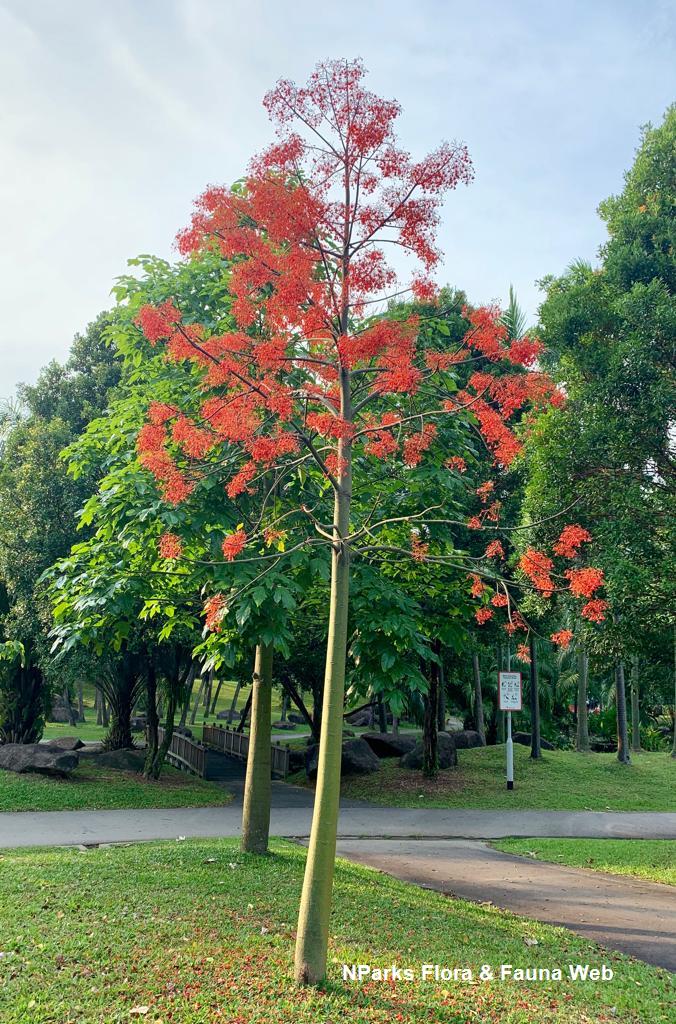
Name
Classifications and Characteristics
| Plant Division | Angiosperms (Flowering Seed Plants) |
|---|---|
| Plant Growth Form | Tree |
| Lifespan (in Singapore) | Perennial |
| Mode of Nutrition | Autotrophic |
Biogeography
| Native Distribution | Australia |
|---|---|
| Native Habitat | Terrestrial |
| Local Conservation Status | Non-native |
Description and Ethnobotany
| Growth Form | Tree with a bulbous trunk, able to grow up to about 18 - 20 m in its natural habitat. |
|---|---|
| Trunk | Trunk is narrow when young, swells up as tree matures and girth size can reach up to 2 - 3.5 m wide. |
| Foliage | Young leaves compound and divided into 3 - 7 narrow lobes, adult leaves tend to be simple and broader. |
| Flowers | Cream to white bell-shaped flowers with red marking borne on a panicle inflorescence, each flower small and with no petals, found in leaf axils, measuring about 0.5 - 1 cm long. |
| Fruit | Fruit is a woody follicle, boat-shaped and measures about 3 cm long, contains 4 - 8 seeds. |
| Others - Plant Morphology | This tree will shed its leaves before the flowering period. |
| Habitat | Endemic to Central Queensland and northern New South Wales. |
| Etymology | Genus Brachychiton is from Greek words "brachy" which means "short" and "chiton" which means "a tunic" and refers to the overlapping scales to the seed coat. Species rupestris means living in rocky places. |
| Ethnobotanical Uses | Edible Plant Parts : Edible Leaves, Edible Seeds, Edible Roots Others: It is an important food source for the ancient Australian Aborigines. |
Landscaping Features
| Landscape Uses | Suitable for Roadsides |
|---|
Plant Care and Propagation
| Light Preference | Full Sun |
|---|---|
| Water Preference | Moderate Water, Little Water |
| Plant Growth Rate | Moderate |
| Rootzone Tolerance | Drought Tolerant |
| Propagation Method | Seed |
Foliar
| Foliage Retention | Evergreen, Drought / Semi-Deciduous |
|---|---|
| Mature Foliage Colour(s) | Green |
| Mature Foliage Texture(s) | Leathery |
| Foliar Type | Compound |
| Foliar Arrangement Along Stem | Alternate, Spiral |
| Foliar Attachment to Stem | Petiolate |
| Foliar Shape(s) | Non-Palm Foliage |
| Foliar Venation | Pinnate / Net, Palmate |
| Foliar Margin | Palmately Lobed |
| Leaf Area Index (LAI) for Green Plot Ratio | 2.5 (Tree - Open Canopy) |
Non - Foliar and Storage
| Trunk Type (Non Palm) | Woody |
|---|---|
| Stem Type & Modification | Woody |
| Specialised Storage Organ(s) | Aboveground (Pachycaul (Swollen Trunk)) |
Floral (Angiosperm)
| Flower & Plant Sexuality | Bisexual Flowers |
| Flower Colour(s) | Cream / Off-White, Pink |
|---|---|
| Flower Grouping | Cluster / Inflorescence |
| Flower Symmetry | Radial |
| Individual Flower Shape | Campaulate / Bell-shaped |
Fruit, Seed and Spore
| Mature Fruit Colour(s) | Brown |
|---|---|
| Fruit Classification | Simple Fruit |
| Fruit Type | Dehiscent Dry Fruit , Follicle |
Image Repository
Others
| Master ID | 1462 |
|---|---|
| Species ID | 2755 |
| Flora Disclaimer | The information in this website has been compiled from reliable sources, such as reference works on medicinal plants. It is not a substitute for medical advice or treatment and NParks does not purport to provide any medical advice. Readers should always consult his/her physician before using or consuming a plant for medicinal purposes. |

